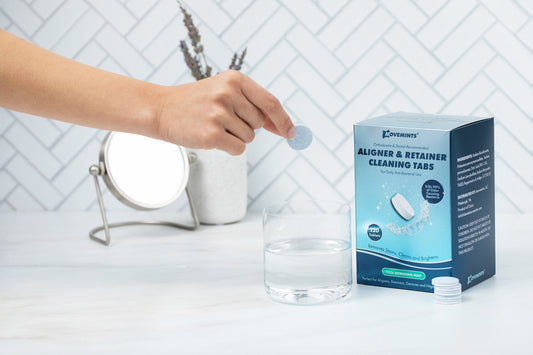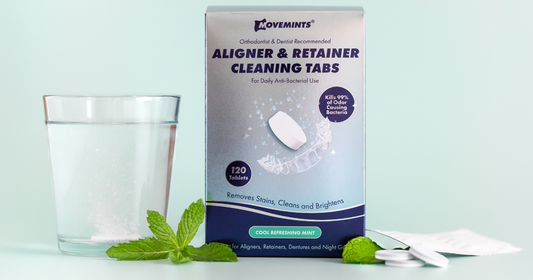Everything You Need To Know About Invisalign Attachments
Nobody expects Invisalign to be easy, and the journey is filled with surprises. Some surprises are great, like how awesome your teeth look after treatment, and others can be a pain in the mouth.
Invisalign attachments are one of those not-so-pleasant surprises, but they're necessary to achieve your ideal smile. But what are they, and how do they work? In this blog, we’ll cover that question and a few others:
- What are Invisalign attachments and why are they necessary?
- What are Invisalign bumps?
- Can I do Invisalign without attachments?
- Do Invisalign attachments hurt?
- What else should I know about Invisalign attachments?
Let's dive in!
What Are Invisalign Attachments And Why Are They Necessary?
Sometimes, your clear aligners aren’t sufficient to achieve your ideal smile. This can be especially true for moderate to advanced cases, where your provider has to deal with stubborn teeth or extreme gaps or crowding. In these cases, they may decide to apply attachments to your teeth to give your trays a little something extra to grip as they guide your teeth into their new position.
Attachments are made from a tooth colored material called composite resin, which is also used in fillings and cosmetic bonding. They are adhered to specific teeth to give your aligners that extra bit of grip they need to move your teeth. Generally speaking, your orthodontist will use them for certain types of movements like rotations, extrusions, or intrusions.
What Are Invisalign Buttons?
Invisalign buttons are one type of attachment, but they aren't they aren't the same thing. Buttons are small auxiliaries that are affixed to your clear aligners (not your teeth, as is the case with attachments) and used as anchors for rubber bands that you will then be asked to wear. The rubber bands act as additional force for your teeth, and are a useful method to ensure that your teeth stay on track with your clear aligner treatment.

These aligners have Invisalign buttons attached to the top and bottom trays.
What Are Invisalign Bumps?
Bite ramps (or "bumps" as they are sometimes called) are another tool in the “stay on track” toolkit, and they serve the same goals as attachments for Invisalign. The difference is that bite ramps (sometimes called “bumps”) are built into the plastic Invisalign tray to help open your bite vertically when your orthodontist determines it necessary.
While attachments, buttons, and bite ramps may all sound like headaches, they are actually quite a blessing for clear aligner patients. Without these additional options, clear aligners may not be a viable treatment method for those who need moderate to complex correction, meaning the only option would be traditional metal braces. So it could be worse, right?
Can I Do Invisalign Without Attachments?
While attachments don’t necessarily accelerate treatment, they are important tools for your orthodontist to help you achieve your ideal smile. So while you certainly can do Invisalign without attachments, keep in mind you may compromise your results and potentially lengthen your treatment.
If you are thinking about refusing attachments, consider these next few points. While you may have heard stories about Invisalign attachments staining teeth, this is not something to be overly concerned about. While the attachments themselves may experience slight staining around their perimeter, it will hardly be noticeable when you are wearing your trays.
Also, none of these attachments pose any risk to your teeth. They will not damage your enamel or put you at risk for tooth loss or decay. Attachments, buttons and bite ramps are perfectly safe for your teeth!
With that said, if your goal is to treat a more mild case of crowding or spacing without the use of attachments, you can potentially save money, skip the extra trips to the dentist, and achieve comparable results by opting for at-home clear aligner treatment. Several popular online aligner companies like Byte and Smile Direct make the process easy to do from your own home, and you still have a dentist or orthodontist to oversee your care remotely and without the use of attachments.
Do Invisalign Attachments Hurt?
You can expect a little bit of discomfort in the days after they are applied, but not because of the attachments themselves (it’s not like they are drilled or bolted on or anything). No, the discomfort comes from the increased orthodontic force that attachments enable for your clear aligners, causing your teeth to move more dramatically than they had before. The more you wear your aligners with your attachments (and the same goes for bite ramps and buttons), the faster you’ll get used to the discomfort! Within a day or two, the soreness will be a thing of the past.

Trust your provider; if they recommend attachments, it's because they're on team "perfect smile"!
Eating with Invisalign attachments will definitely take some adjustment, but by this point in your treatment you’re probably quite used to making such accommodations! But do take care; because the attachments provide more places for food and bacteria to hide out, it’s a good reminder to assess your hygiene habits. Are you brushing after every meal and flossing as often as possible? These habits are essential during treatment, but especially when you have attachments. Give any newly-attached teeth a little extra attention to ensure they’re extra clean.
If you are really worried about staining, be mindful of coffee or red wine or other beverages that cause discoloration. If you can avoid them while you have your attachments, that’s best, but know that even if you do get some stains, they’ll be hardly noticeable behind your trays which you’ll be wearing for 22 hours a day!
One thing we do not recommend is teeth whitening when you have attachments on your teeth, because the resin itself cannot be whitened. You also won’t be able to whiten the part of your teeth covered by the attachments, so you'll have small discoloration marks on your teeth where the attachments were. So wait until they're off to whiten up.
What Else Should I Know About Attachments For Invisalign?
Patients always ask “are Invisalign attachments noticeable?” You are going to notice them for sure, but will every person you meet know that you’ve got tiny dots of composite resin on your teeth? Of course not! And one thing’s for sure, they’re a lot less noticeable than metal braces, and you can take comfort knowing they aren't permanent, and that your smile will be better for it!
We’ve also heard that some people (on the internet at least) are asking how to remove Invisalign attachments yourself. Under no circumstances should you attempt to remove attachments on your own! First of all, they are on for a reason, and when your provider determines they’ve done their job, they’ll get them off for you. The process is relatively painless, though it does involve using the drill to wear away the resin. Watch this video if you’re really curious to see Invisalign attachments removed (and you’ll also see why you shouldn’t do it yourself!).
A few other notes. Some patients can have multiple attachments placed on one tooth (it’s all about grip), and sometimes it’s necessary to have an entirely new set of attachments placed on your teeth. This is most common if you are undergoing refinements. Contrary to what you might think, attachments can wear out over time. While your provider will be keeping an eye out for this, you should certainly let them know if you feel like one has chipped or worn down significantly. Finally, at the time of this writing, attachments are the domain of orthodontists. At home providers don’t currently offer attachments with their treatment plans.
Did we cover all your questions about Invisalign attachments? Let us know in the comments section and we’ll update this blog accordingly!
Further Reading: Invisalign Q&A - Everything You Need to Know About Invisalign Aligners




